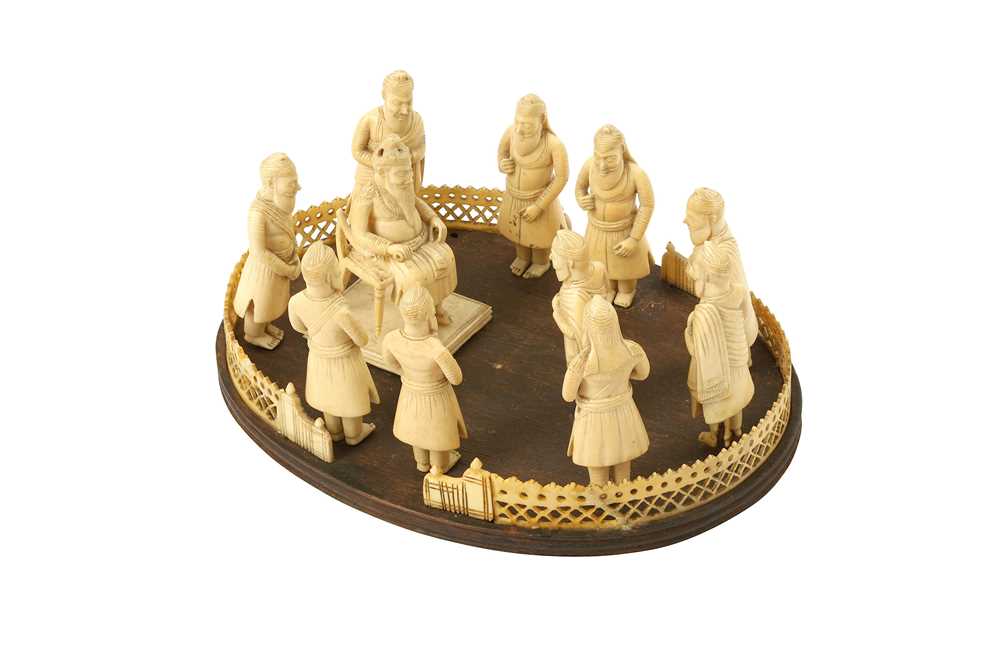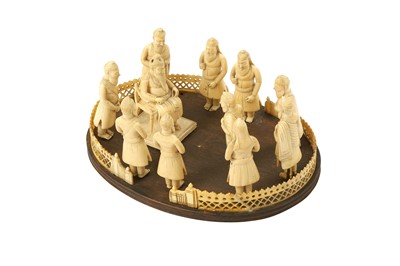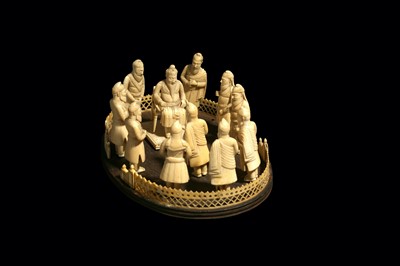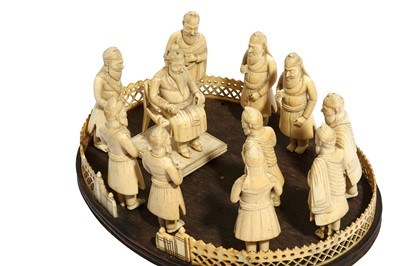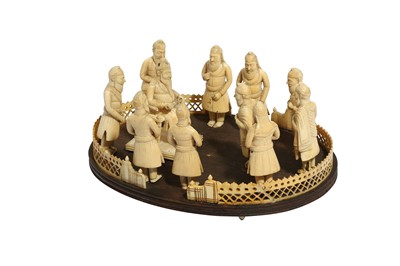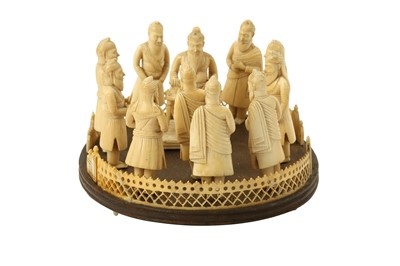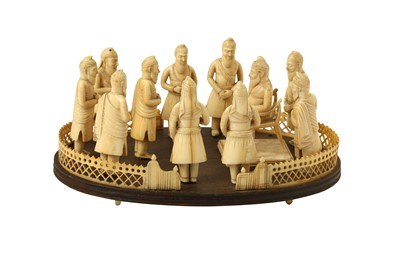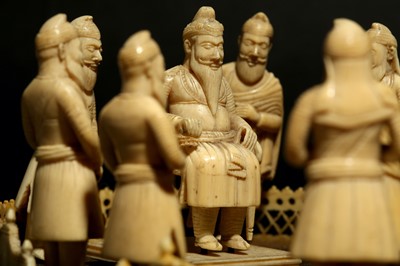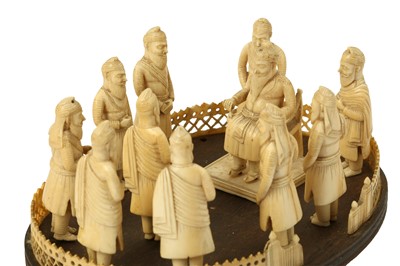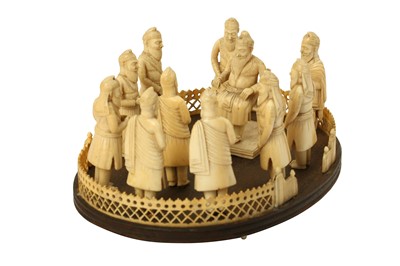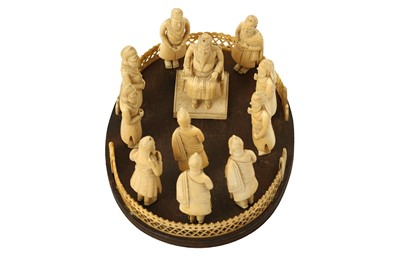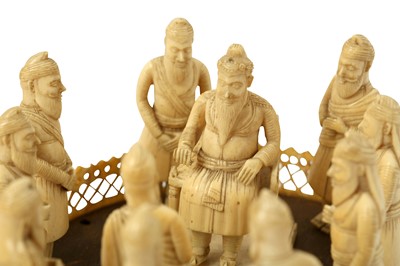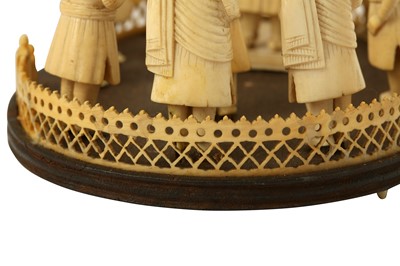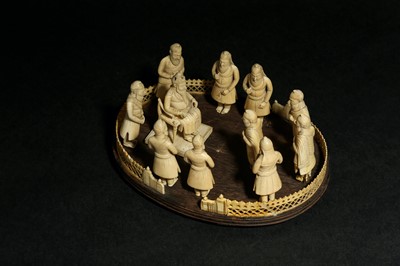29th Oct, 2021 14:00
Islamic & Indian Art
λ ELEVEN CARVED IVORY FIGURES OF THE FIRST SIKH RULER, MAHARAJA RANJIT SINGH, AND HIS COURT
Delhi, Northern India, first half 19th century
λ ELEVEN CARVED IVORY FIGURES OF THE FIRST SIKH RULER, MAHARAJA RANJIT SINGH (1780 - 1839), AND HIS COURT
Delhi, Northern India, first half 19th century
Comprising a carved ivory figure of the renowned Sikh ruler, Ranjit Singh, seated on a backless wooden chair set on a square pedestal, surrounded by further ten ivory figures of standing courtiers, including family members, ministers, assistants and generals, each figure pinned onto the dark wood oval base resting on four rounded ivory feet and enhanced on the exterior by a pierced reticulated fence imitating Northern Indian architectural models, the full set 15.5cm x 6.5cm, each figure approx. 5.5cm high.
Ivory figurines and models, occasionally painted, often simply engraved, were a popular creation in 19th-century India, and Delhi was a known centre of ivory carving. The subjects could be the most varied, but from the remaining visual evidence, villagers, craftsmen, members of the court, and renowned rulers seem to have been among the most popular.
Our group of eleven ivory figurines represents a gathering at the court of Maharaja Ranjit Singh, and it is likely to have been produced in Delhi around 1830 - 1840. Our figures share a degree of similarity in terms of style, decorative technique and design with a standing ivory figurine of the first Sikh ruler in the Victoria and Albert Museum's collection (IS.60-1998), dating to the same period. Even if Ranjit Singh was renowned for his simple dress and plain features, his ivory carvings tend to often give the Maharaja the majestic appearance and jewellery of a Mughal emperor, as evident in the bejewelled epaulettes, necklace and heavily encrusted sarpech (turban ornament) featuring in both the V&A Museum and our statuettes. Moreover, in both cases, the artist paid attention to the Maharaja's blind left eye, a scarring mark left on the ruler by smallpox, from which he had suffered at a young age. Indeed, under a magnifying glass, one can appreciate that the left eye on both figurines has a mark next to the pupil, indicative of the ruler's condition.
Several figurines in our lot present holes in either their hands or on their heads. These holes must have been once filled with attributes and accessories, now missing. For example, Ranjit Singh's turban presents two cavities, indicating they may have been filled with further turban ornaments like the black heron feather featured in several of his ivory miniature portraits and in the large composition of the ruler and his court attributed to Bishan Singh, dated 1870 - 71, sold at Sotheby's earlier this year (Sotheby's London, 31 March 2021, lot 44). His hands were also once holding an attribute, most probably a sword or a document scroll holder, now missing, similarly to the painted ivory figurine of the ruler offered at Bonhams in an Online Only sale last May (Bonhams London, 19 - 27 May 2021, lot 244). Lastly, the outfits of the Maharaja and his courtiers are almost identical to another ivory figurine of the same period successfully sold at Bonhams (Bonhams London, 26 October 2020, lot 241), indicating that the Northern Indian ivory carvers were possibly drawing their inspiration for the ruler's model from a single, main source. It has been speculated that this source could be an illustrated copy of the Tazkirat ul-'Umara (Historical Notices of Princely Families [of Rajasthan and the Punjab]) by Colonel James Skinner, dating to 1830 (S. Stronge, The Arts of the Sikh Kingdoms, 1999, cat. 101, p. 222).
A similar court scene made of painted and gilt ivory, and representing the Mughal Emperor Akbar Shah II listening to singers and musicians was exhibited at the British Library, Mughal India: Art, Culture and Empire, 9 November 2012 - 2 April 2013, London [image reproduced and released from the British Library Board - available via email for reference only].
This item may require Export or CITES licences in order to leave the UK or the European Union. It is the buyer's responsibility to ensure that lots have the relevant licences before shipping.
Dimensions: the full set 15.5cm x 6.5cm, each figure approx. 5.5cm high
Provenance: Purchased in a small provincial auction in Bury St. Edmunds, Suffolk, UK, in 2007, previously in a local private collection.
Bury St. Edmunds is a site in Suffolk dear to the British Sikh community given its connection to Maharaja Duleep Singh. He took an active interest in the local surroundings, architecture and history, and helped save the local Adam-style town hall. For further reference, please see The Maharajah Duleep Singh Family - East of England Heritage Trail brochure (https://essexcdp.com/wp-content/uploads/2020/02/DuleepSInghTrail.pdf - last accessed 27/09/2021).
Do you have an item similar to the item above? If so please click the link below to request a free online valuation through our website.
